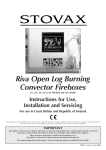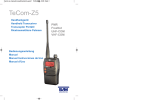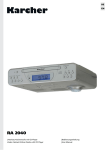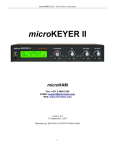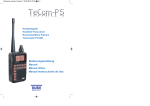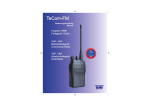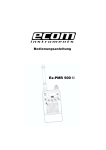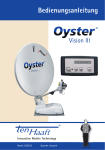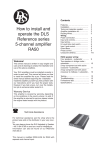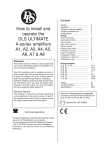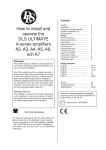Download TeCom-IP2 - Diesnerfunk
Transcript
tc-ip2_manual:TeCom-IP_manual 8/8/2014 11:09 AM Seite 1 TeCom-IP2 Handfunkgerät Handheld Transceiver Transceptor Portátil Ricetrasmettitore Palmare Bedienungsanleitung Manual Manual Instrucciones de Uso Manual d’Uso PMR UHF-COM tc-ip2_manual:TeCom-IP_manual 8/8/2014 11:09 AM Seite 2 Deutsch Deutsch Inhaltsverzeichnis Sehr geehrte Kundin, sehr geehrter Kunde, es freut uns, dass Sie sich für den Kauf eines TEAM TeCom-IP2 entschieden haben. Um einen einwandfreien Betrieb zu gewährleisten und um die verfügbaren Funktionen im vollen Umfang nutzen zu können, bitten wir Sie die nachfolgende Bedienungsanleitung vor Inbetriebnahme des Gerätes gründlich zu lesen. Das TeCom-IP2 ist in den folgenden Versionen erhältlich. TeCom-IP2 PMR - Art-Nr. PR8096 Das PMR-Funkgerät darf jeder anmelde- und gebührenfrei in den Ländern gemäß der beiliegenden Konformitätserklärung betreiben. Es sind die acht PMRKanäle auf 446 MHz mit der maximal zulässigen Ausgangsleistung von 500 mW programmiert. Eine Veränderung der programmierten Frequenzen, der Sendeleistung oder der Bandbreite des Geräts ist nicht zulässig und führt zum Erlöschen der Betriebsgenehmigung. TeCom-IP2 (UHF-COM) - Art.-Nr. PR8097 Das Betriebsfunkgerät ist genehmigungs- und gebührenpflichtig und darf nur in den Ländern gemäß der beiliegenden Konformitätserklärung betrieben werden. Es dürfen nur behördlich genehmigte Funkfrequenzen zwischen 410-470 MHz, Sendeleistungen und Bandbreiten programmiert werden. Die Programmierung darf nur von einem autorisierten Fachhändler durchgeführt werden. Für die Programmierung des TeCom-IP2 benötigen Sie die optional erhältliche Software T-UP30 (CD-ROM für Windows XP / 7 & 8 und USB-Datenüberspielkabel), erhältlich in den Versionen PMR und COM. ALLGEMEIN Vor Inbetriebnahme Lieferumfang Pflege IP67 Gerätebeschreibung Seite 4 4 4 4 4 5 GRUNDFUNKTIONEN Anschluss der Antenne Akkupack Laden des Akkupacks Ein- und Ausschalten Einstellen der Lautstärke Kanalwahl Senden Empfang 6 6 6 6 6 6 7 7 7 TASTENFUNKTIONEN PTT Sendetaste Multifunktionstasten 1 & 2 8 8 WEITERE FUNKTIONEN Suchlauf CTCSS/DCS Rauschsperre Warnton Sprachansage Scrambler Compander Epilogue Purge Voice Sendesperre Sendezeitbegrenzung Batteriesparfunktion Incept Alarm Bandbreite UKW Radio 9 9 9 9 9 10 10 10 10 10 10 10 11 11 11 ANSCHLUSS 11 CTCSS / DCS 42 TECHNISCHE DATEN 43 tc-ip2_manual:TeCom-IP_manual 8/8/2014 11:09 AM Seite 4 Deutsch Deutsch Gerätebeschreibung ALLGEMEIN Vor Inbetriebnahme Bitte überprüfen Sie die Ware sofort beim Empfang auf Vollständigkeit gemäß der folgenden Liste. Informieren Sie Ihren Händler sofort bei Unvollständigkeit. Lieferumfang 1 x TeCom-IP2 inkl. Antenne 1 x Akkupack 1 x Ladegerät 1 x Bedienungsanleitung 1 x Gürtelclip 1 x Ohrhörer/Mikrofon Pflege Bitte beachten Sie die folgenden Hinweise um die optimale Lebensdauer und Funktionstüchtigkeit Ihres Gerätes zu gewährleisten. w Öffnen Sie nicht das Gehäuse. Unsachgemäßes Öffnen kann Schaden zur Folge haben. Des weiteren verlieren Sie jegliche Gewährleistungsansprüche. w Verwenden Sie zum Laden des Akkupacks nur das im Lieferumfang enthaltene Ladegerät. 1 - Antenne 2 - Lautsprecher 3 - Mikrofon 4 - Kanalwahldrehschalter 5 - Ein/Aus - Lautstärkeregler 6 - LED 7 - PTT Sendetaste 8 - Funktionstasten (Monitor, Alarm, Sendeleistungsumschaltung) 9 - Akkupack Verschluss 10 - Anschluss für Ohrhörer-Mikrofon und Programmierkabel 3,5 / 2,5 mm 11 - Polymer Li-Ion Akkupack 12 - Gürtelclip 1 4 5 6 2 3 w Bewahren Sie das Gerät niemals an Plätzen auf die dem direkten Sonnenlicht oder anderen Hitzequellen ausgesetzt sind. Hohe Temperaturen können die Lebensdauer bestimmter elektronischer Bauteile beeinträchtigen und Plastikteile können schmelzen. w Bitte bewahren Sie das Gerät nicht in staubigen oder verschmutzen Räumen auf. w Sollte das Gerät ungewöhnlich heiß werden, ungewöhnliche Gerüche abgeben oder es zu einer Rauchentwicklung kommen, schalten Sie bitte das Gerät sofort ab und entnehmen den Akkupack. Kontaktieren Sie bitte sofort Ihren Händler. w Senden Sie niemals ohne Antenne. Eine Beschädigung der Endstufe wäre die Folge. w Damit keine Feuchtigkeit eindringt, prüfen und reinigen Sie die Gummidichtung auf der Innenseite des Akkupacks. Prüfen Sie auch, ob der Akku-Verschluß fest schließt. 10 7 IP67 Das TeCom-IP2 ist spritzwasser- und staubgeschützt nach dem ICE Standard IP67. Die IP67 Schutzklasse berücksichtigt keine Alterung des Geräts und kann deshalb nicht über die gesamte Lebensdauer des Geräts gewährleistet werden. 8 10 11 Bitte beachten Sie folgende Hinweise wenn Ihr TeCom-IP2 nass geworden sein sollte: 1. Schalten Sie das Gerät aus. 2. Entfernen Sie den Akkupack. 3. Trocknen Sie den Akkupack, das Gehäuse, sowie das Batteriefach mit einem trockenem, staubfreien Tuch. 4. Lassen Sie das Gerät für einige Zeit im trockenem Raum liegen bevor Sie den Akkupack wieder montieren und das Gerät einschalten. 4 12 9 5 tc-ip2_manual:TeCom-IP_manual 8/8/2014 11:09 AM Seite 6 Deutsch Deutsch GRUNDFUNKTIONEN Anschluss der Antenne Hinweis: in der PMR Version TeCom-IP2 PMR ist die Antenne gemäß gesetzlicher Vorgaben fest mit dem Gerät verbunden. In der Variante TeCom-IP2 COM ist die Antenne abnehmbar. Den Antennenfuß gerade auf das Gewinde setzen und im Uhrzeigersinn festdrehen. Beim Lösen der Antenne bitte darauf achten, die Antenne am Fuß, und nicht an der Spitze, zu drehen. Akkupack Um den Akkupack (11) an das Gerät zu montieren, fügen Sie die Führungsnasen am oberen Teil des Akkupacks in die entsprechenden Führungslöcher am Gerät ein. Drücken Sie den Akkupack am unteren Ende fest gegen das Gerät. Legen Sie die Akku-Arretierung (9) gegen den Akkupack und drücken Sie diesen gegen das Gerät bis der Verschluß einrastet. Zum Entfernen des Akkupack, öffnen Sie den Verschluss (9) (zwischen den Batteriekontakten, beschriften mit OPEN) mit dem Zeigefinger. Hinweis: Achten Sie darauf, die im Akkupack hellblau gekennzeichnete Gummidichtung nicht zu beschädigen. Kanalwahl Für die Kanalwahl steht der Kanalwahldrehschalter (4) zur Verfügung.Wenn der Warnton und die Sprachansage aktiviert ist, ist ein Beepton zu hören und der jeweils eingestellte Kanal wird in englischer Sprache angesagt. Senden Zum Senden halten Sie bitte die Sendetaste (7) bis kurz nach Beendigung Ihrer Nachricht gedrückt. Für eine optimale Signalübertragung sprechen Sie bitte mit mittellauter Stimme in einem Abstand von ca. 10 cm zum Mikrofon (3). Während des Sendevorgangs leuchtet die Kontroll-LED (6) rot auf. Nach dem Loslassen der Sendetaste kehrt das Gerät automatisch wieder in den Empfangsmodus zurück. Empfang Beim Empfang eines Signales leuchtet die Kontroll-LED (6) grün. Wenn die Frequenz mit einer CTCSS- / DQT-Kodierung belegt ist, werden alle Signale die nicht mit derselben Kodierung versehen sind, stummgeschaltet. D.h. die grüne Kontroll-LED leuchtet, jedoch ist kein Signal im Lautsprecher hörbar. Laden des Akkupacks Vor dem ersten Betrieb sollte der Akkupack komplett geladen werden. Die durchschnittliche Ladedauer beträgt etwa 6 Stunden. Verbinden Sie das Kabel des Netzadapters mit der Ladeschale und stecken dann den Netzadapter in eine 220 V Steckdose. In Betriebsbereitschaft leuchtet die LED grün. Stellen Sie das Gerät in die Ladeschale und achten Sie auf die richtige Platzierung. Während des Ladevorgangs leuchtet die LED rot. Ist der Ladevorgang abgeschlossen, schaltet die LED auf grün um. Nehmen Sie das Gerät nach Ende des Ladevorgangs aus der Ladeschale. Hinweis: Überladen des Akkus verkürzt dessen Lebensdauer. Ein- und Ausschalten Um das Gerät einzuschalten, drehen Sie den Ein- / Ausschalter (5) im Uhrzeigersinn über die Sperre hinweg. Bei aktiviertem Beepton wird der Einschaltvorgang akustisch bestätigt, bei aktivierter Sprachansage in gewählter Sprache angesagt. Um das Gerät auszuschalten, drehen Sie bitte den Ein- / Ausschalter (5) gegen den Uhrzeigersinn über die Sperre hinweg. 6 Einstellen der Lautstärke Zum Einstellen der optimalen Lautstärke, drücken Sie bitte die mit der Monitorfunktion belegten Funktionstaste (8) und stellen mit dem kombinierten Ein-/Aus-/Lautstärkeregler (5) die gewünschte Lautstärke ein. Hinweis: Die Programmierung der Funktionstaste geschieht mit der optionalen Software T-UP30. nur Version TeCom-IP2 UHF COM 7 tc-ip2_manual:TeCom-IP_manual 8/8/2014 11:09 AM Seite 8 Deutsch Deutsch TASTENFUNKTIONEN PTT Sendetaste Die Sendetaste (7) befindet sich auf der linken Geräteseite. Drücken der Sendetaste schaltet das Gerät in den Sendemodus. Während des Sendens leuchtet die LED (6) rot auf. Multifunktionstaste 1 / 2 Die beiden Funktionstasten 1 und 2 (8) befindet sich unterhalb der PTT-Sendetaste (7). Sie können per Software jeweils wahlweise mit einer der folgenden Funktionen belegt werden. Aus (Off) Monitor (Monmome) Leistungsumschaltung (H/L Power) Notruf (Alarm) Aus Der Taste ist keine Funktion zugewiesen. Monitor Die Rauschsperre wird deaktiviert und das typische Rauschen des Frequenzbandes ist hörbar. Diese Funktion ermöglicht es schwache Signale hörbar zu machen, welche von der Rauschsperre ausgefiltert werden. Leistungsumschaltung Es wird zwischen der hohen (High) und niedrigen (Low) Sendeleistung umgeschaltet. In der PMR-FreeNet Version betragen die Werte High = 500 mW und Low = 300 mW. Notruf Alarm Es wird ein konstanter Notrufton am eigenen Gerät ausgesendet, der nicht auf dem eingestellten Kanal hörbar ist. Zum Ausschalten des Alarms die Funktionstaste drücken oder das Gerät ausschalten. WEITERE FUNKTIONEN Die Einstellungsänderungen der folgenden Funktionen werden via Software vorgenommen. Suchlauf Die Suchlauffunktion wird zum Auffinden von Signalen auf Frequenzen der Kanalsuchlaufliste eingesetzt. Die programmierten Kanäle können per optionaler Software der Kanalsuchlaufliste hinzugefügt werden. Die Suchlauffunktion wird via Sofware aktiviert bzw. deaktiviert. Bei aktivierter Funktion ist der Kanal 16 mit der Suchlauffunktion belegt. Dieser Kanal ist dann nicht für die Funkkommunikation verfügbar. Zum Starten des Kanalsuchlaufs, den Kanalwahldrehschalter (4) auf Kanal 16 stellen. Sobald ein Signal auf einem der Kanäle der Kanalsuchlaufliste gefunden wird, leuchtet die LED grün. Endet das Signal erlöscht die LED. 3 Sekunden nach Signalende fährt die Suchfunktion fort. Mit Verlassen des Kanals 16, wird der Kanalsuchlauf beendet. CTCSS/DCS Die 39 CTCSS und 166 DCS Kodierungen (83 x einfach und 83 x umgekehrt) dienen der Blockade unerwünschter Signale. D.h. bei aktivierter Kodierung werden nur Signale mit der entsprechenden Kodierung im Lautsprecher hörbar. Jedem Kanal kann via Software eine Empfangs- und eine Sendekodierung zugewiesen werden. Hinweis: kodierte Signale sind für andere Teilnehmer unter Umständen hörbar, z.B. mit Hilfe der Monitorfunktion, und sind somit nicht geeignet für ein privates Funknetz. Rauschsperre Via Software kann die Empfindlichkeit der Rauschsperre zwischen 0 und 9 eingestellt werden, wobei die Stufe 0 der geringsten Empfindlichkeit entspricht. Die Rauschsperre ist bei dieser Einstellung komplett geöffnet. Auf Stufe 9 muss das Signal sehr stark sein um die Rauschsperre zu deaktivieren. Warnton Bei aktivierter Warntonfunktion wird das Einschalten, der Kanalwechsel und das Umschalten der Sendeleistung, bei entsprechender Programmierung der Funktionstaste, durch einen kurzen Ton angekündigt. Diese Funktion wird via Software aktiviert bzw. deaktiviert. Sprachansage Bei aktivierter Sprachansage wird die aktuelle Kanalnummer nach dem Umschalten in englischer Sprache angesagt. Diese Funktion wird via Software aktiviert bzw. deaktiviert. 8 9 tc-ip2_manual:TeCom-IP_manual 8/8/2014 11:09 AM Seite 10 Deutsch Scrambler Die Sprachverschleierung (Scrambler) ist via Software für jeden Kanal individuell einstellbar. Bei aktiver Scrambler Funktion ist das verschlüsselte Signal für Empfänger ohne passende Entschlüsselung schlecht verständlich, d.h. sehr stark verzerrt. Somit wird das Mithören anderer Teilnehmern, welche nicht als Empfänger bestimmt sind erschwert. Hinweis: Da es allgemein verschiedene Scrambler-Verschlüsselungsraten gibt, kann es mit Geräten anderer Hersteller oder anderen Modellen Kompatibilitätsprobleme geben. Compander Für die Signal-Optimierung steht die Compander Funktion, d.h. sendeseitige Kompression und empfangsseitige Expansion, zur Verfügung. Diese Funktion kann für jeden Kanal individuell via Software aktiviert bzw. deaktiviert werden. Epilogue Eine weitere Funktion für die Signaloptimierung steht mit der Epilogue-Funktion zur Verfügung. Eventuell auftretende Störgeräusche am Ende des Signals, wie z.B. Klickgeräusche, können reduziert werden. Diese Funktion ist individuell für jeden Kanal einstellbar. Purge Voice Die Signaloptimierung Purge Voice empfiehlt bei lauten Hintergrundkulissen. Die Funktion dient der klareren Abtrennung von Stimme zu Hintergrundgeräuschen und wird per Software programmiert. Es stehen drei Abstufungen zur Auswahl. Sendesperre Diese Funktion verhindert das versehentliche Senden auf besetzten Kanälen. Wird die Sendetaste (7) während des Empfangs eines Signales auf dem aktuell eingestellten Kanal gedrückt, ertönt bei aktivierter Warnton-Funktion eine lauter Beepton und der Sendemodus ist blockiert. Die Sendesperre (Busy Lock) kann für jeden Kanal individuell via Software aktiviert bzw. deaktiviert werden. Sendezeitebegrenzung Allgemein: Im Sendebetrieb ist der Stromverbrauch höher als im Empfangs- bzw. Ruhezustand. Überlanges Senden reduziert somit die Akku-Kapazität sehr schnell und erhitzt das Gerät übermäßig. Um überlanges Senden zu verhindern, kann die max. Sendezeit via Software zwischen 15 und 600 Sekunden in 15-Sekunden-Intervallen eingestellt werden. Deutsch Incept Alarm Nach dem Empfang eines Signals ertönt ein lauter Warnton, der den Benutzer, welcher sich nicht in unmittelbarer Nähe des Funkgerätes befindet, über den Signalempfang informiert. Ein- und Ausschaltung dieser Funktion geschieht via Software. Bandbreite Für die anmelde- und gebührenfreien Versionen PMR und FreeNet ist die Bandbreite fest auf 12,5 kHz (Narrow) eingestellt. Für die anmelde- und gebührenpflichtigen Betriebsfunkversionen UHF- und VHF-COM sind via Software die Bandbreiten 12,5 kHz (Narrow), 20 kHz (Middle) und 25 kHz (Wide) wählbar. In Deutschland sind für den Betriebsfunk 12,5 / 20 kHz Bandbreite vorgeschrieben. UKW Radio Zum Einschalten des Radios bitte die obere Funktionstaste (8) während des Einschaltens gedrückt halten. Zum Einstellen eines gewünschten Kanals ist das TeCom-IP2 mit einer Suchlauffunktion ausgestattet. Kurzes Drücken der Funktionstaste (8) startet die Suchlauffunktion welche nach Auffinden eines Kanals automatisch endet. Zum Ausschalten der Radiofunktion die obere Funktionstaste (8) gedrückt halten bis ein Doppelton zu hören ist. Die Radiofunktion wird automatisch beim Empfang und Senden eines Funksignals ausgeschaltet. ANSCHLUSS Das TeCom-IP2 verfügt über eine Motorola-kompatible Anschlussbuchse (10) für den Anschluss von Zubehör, wie z.B. Ohrhörer-Mikrofone (3,5/2,5 mm - Mono/Mono) und das PC-Übertragungskabel für die Software. Passendes Zubehör finden Sie auf der Webseite www.team-electronic.de. Batteriesparfunktion Zwecks Stromsparung kann die Umschaltung in den StandBy-Betrieb gesteuert werden. Via Software sind die Auswahlmöglichkeiten 1:1, 1:2; 1:3 und 1:4 verfügbar. 10 11 tc-ip2_manual:TeCom-IP_manual 8/8/2014 11:09 AM Seite 12 English English Table of Contents page Dear Customer, We are proud that you decided to purchase a TEAM TeCom-IP2 handheld transceiver. Please read the following instructions prior to the first use for your safety, a smooth operation of the radio and full knowledge of your radios capabilities. The TeCom-IP2 is available in these versions: TeCom-IP2 PMR PR8096 : programmed with 8 PMR* channels, 500 mW tx power, bandwidth 12.5 kHz, no registration or fees apply TeCom-IP2 UHF-COM: commercial radio; 16 channels programmable; PR8097 registration and fees apply; only assigned frequencies and parameters are allowed to be programmed; bandwidth 12.5 / 20 / 25 kHz; max. TX power 4 W; UHF 400 - 470 MHz Programming of the TeCom-IP2 is done via the additional software T-UP30. A USB data transfer cable is included in the scope of delivery. The software is available in the versions T-UP30 COM for the commercial versions UHF-COM and TUP30 PMR (Windows XP, 7 & 8). * = PMR Frequencies 1 - 446.00625 MHz 2 - 446.01875 MHz 3 - 446.03125 MHz 4 - 446.04375 MHz 5 - 446.05625 MHz 6 - 446.06875 MHz 7 - 446.08125 MHz 8 - 446.09375 MHz 12 ** = FreeNet Frequencies 1 - 149.0250 MHz 2 - 149.0375 MHz 3 - 149.0500 MHz 4 - 149.0875 MHz 5 - 149.1000 MHz 6 - 149.1125 MHz GENERAL prior to first use scope of delivery maintenance IP67 elements 14 14 14 14 15 BASIC FUNCTIONS antenna connection battery pack charging of the battery on / off volume channel selection transmission reception 16 16 16 16 16 17 17 17 KEY FUNCTIONS PTT key function key 1 / 2 18 18 ADDITIONAL FUNCTIONS scan CTCSS/DCS squelch warn tone voice annunciation scrambler compander epilogue voice purge busy lock time-out-timer battery saving functions incept alarm vol inhibit bandwidth fm radio 19 19 19 19 19 20 20 20 20 20 21 21 21 21 21 21 CONNECTION 21 CTCSS / DCS 42 SPECIFICATIONS 43 13 tc-ip2_manual:TeCom-IP_manual 8/8/2014 11:09 AM Seite 14 English English GENERAL Elements Scope of Delivery Unpack the equipment carefully. Identify and check the listed items. Keep packaging, manual and declaration of conformity in a save place. If any items have been damaged during shipment or are missing, please contact your dealer immediately. Supplied Accessories 1 x antenna (attached with PMR version) 1 x belt clip 1 x charger 1 x manual 1 x battery pack 1 x earphone/microphone Maintenance For best performance and functionality of the TeCom-IP2, please pay attention to the following advices. w Do not open the case of the radio. Improper opening may cause damages and warranty claims are forfeited. w For charging of the rechargeable battery pack, only use the charger SLG-TeCom-IP that is included in the scope of delivery. w Never expose the radio to direct sunlight or other heat sources. High temperatures will diminish the longevity of certain components and plastic parts may melt and deform. w Never store the radio in dusty or dirty areas. w Should the radio generate unusual heat or emit unusual smell or even smoke, please turn the radio off immediately and remove the battery pack. Contact your dealer. w Never transmit without antenna. A damage of the power amplifier may be the result. w To ensure that no liquid enters the radio case, check and clean the rubber seal on the inside of the battery pack. Also, always make sure that the latch of the battery pack is closed properly. 1 - antenna 2 - speaker 3 - microphone 4 - rotary channel selector 5 - on/off - volume control 6 - LED 7 - PTT key 8 - function keys 1 / 2 (monitor, alarm, tx power switch) 9 - lock battery pack 10 - connector for ear-/microphone and programming cable 3.5 / 2.5 mm 11 - Polymer Li-Ion battery pack 12 - Beltclip 4 5 6 2 3 10 IP67 The TeCom-IP2 is approved according to the ICE standard IP67. This Ingress Protection Rating, issued by the international electrotechnical commision (IEC) indicates protection against dust and from low water pressure. The IP67 protection rating does not consider advanced wear and tear of the equipment and, therefore, cannot be guaranteed for the entire lifespan. Nevertheless, should the TeCom-IP2 have been exposed to splashwater, please follow these steps for prolonged longevity. 1 7 8 12 10 11 9 1. Turn the radio off. 2. Take off the battery pack. 3. Dry off excessive water on the case and in the battery compartment. 4. Let the radio air out until completely dry before reusing. 14 15 tc-ip2_manual:TeCom-IP_manual 8/8/2014 11:10 AM Seite 16 English English BASIC FUNCTIONS Antenna Due to governmental regulations, with the PMR version the antenna is fixed, i.e. nondetachable. All other versions have a detachable antenna. To mount antenna, place the antenna-base onto the connection thread at the top of the radio, and turn tight in clockwise direction. For detachment, turn the antenna at the base - not at the tip - counterclockwise. Battery Pack To mount the battery pack (11) onto the radio, place the grooves at the top of the battery pack onto the battery compartment of the radio-case and push the battery pack into final position. Then close the latch and push it until it locks in. To remove the battery pack, open the lock (9) by pulling the closure, which is labeled OPEN, with your index finger. Charging Prior to first use, the battery pack (11) has to be fully charged. A complete charging cycle takes approximately 6 hours. Connect the cable of the power supply with the base of the charger before connecting with a 220 V plug. The LED shorty lights up red and then green. Now, place the radio with the attached battery pack (11) into the charger. Pay attention to proper placement. During the charging process, the LED lights red. Once charging is completed, the LED lights green. Take the radio out of the base. Overcharging reduces the battery pack’s longevity. Channel Selection For channel selection use the channel selector (4). If the warn tone and the voice annunciation are activated, a beep tone is emitted and the actual channel number is announced once the channel has changed. Note: The scan function operates on channel 16. If scan is enabled, channel 16 is no longer available for radio communication. If no frequency is programmed on the selected channel, a constant warn tone is audible. Transmit For transmission hold the PTT key (7) until the end of the message. For best sound quality, talk into the microphone (3) at a middle volume level at a distance of approximatly 10 cm. During transmission the control LED (6) lights red. Upon release of the PTT key (7) the radio returns automatically into reception mode. Once a signal is present on the selected frequency, the LED lights green. Reception Once a signal is present on the selected frequency, the LED lights green. Note: If the selected frequency is decoded with a CTCSS-/DCS-code, all signals that are encoded with a different code will be muted. The green LED will light but no signal will be audible. On / Off To switch on the radio, turn the combined on/off-volume switch (5) clockwise beyond the barrier. If the warn tone and the voice annunciation are activated, a beep tone is emitted and the actual channel number is announced. To switch off the radio, turn the on/off-volume knob (5) counterclockwise beyond the barrier. Volume Control Use the combined on/off-volume knob (5) for volume control. Turning clockwise increases the volume level and turning counterclockwise reduces it. To set a comfortable volume level after turning the radio on, hold the function key (8) key has to be programmed with the monitor function - while adjusting the volume level with the combined on/off-volume switch (5). Note: The function key (8) can be programmed via software with one of these functions: monitor, tx-power high/low and alarm. 16 TeCom-IP2 UHF COM version only 17 tc-ip2_manual:TeCom-IP_manual 8/8/2014 11:10 AM Seite 18 English English KEYPAD FUNCTIONS PTT Key The PTT key (7) is located at the left side of the radio. Pressing the PTT key will activate transmission mode. The LED (6) will light red. Function Key 1 / 2 The function keys 1 and 2 (8) are located under the PTT key (7). They can be indiviually programmed with one of these functions: Off no function available Alarm By pressing the function key (8) a constant alarm tone is audible. Transmission and reception modes are blocked. To turn off the alarm, press the function key (8) or turn the radio off. Monitor The monitor function deactivates the squelch and the typical constant noise is audible. Weak signals that would not pass the squelch and signals that are CTCSS/DCS encoded can be heard with the monitor function. TX Power The low tx power is indicated by a single warn tone and the high tx power by a double-tone. Note: With the versions PMR, the low tx power are fixed to 300 mW and the high value to 500 mW. With the COM versions the max. tx power is 4 W for UHF. The low and high tx power values can be set via software according to the commercial radio licence. ADDITIONAL FUNCTIONS The following functions are managed via software. This applies to activation and change of settings. scan The scan function searches signals on the programmed frequencies that are added to the scan list. A programmed channel can be added or deleted from the scan list via software. The scan list needs to contain at least two channels. If the scan function is actived, channel 16 is reserved for this function and communication is no longer possible on this channel. Once a signal is detected the LED lights green, the scan function is paused and the radio remains on the channel until the end of the signal. Then, after appr. 3 seconds, the scan function continuous. To end the scan function leave channel 16 by switching to another channel. CTCSS/DCS 39 CTCSS and 166 DCS (83 plus 83 reversed) codes are available to filter-out unwanted signals, i.e. with activated CTCSS/DCS coding, only signals with the matching code are audible. Signals with differing codes are muted. Each channel can be assigned to one CTCSS/DCS code for the transmission frequency and one code for the reception frequency. Note: CTCSS/DCS does not guarantee privacy. Encoded signals are received by radios that do not use CTCSS/DCS. Also, using the monitor function makes CTCSS/DCS encoded signals audible. squelch The squelch sensitivity can be set via software, on a scale between 0 and 9. With the value 0, the squelch is turned off and the entire frequency is audible. With value 9, only the strongest signals will pass through the filter. warn tone A short beep tone is audible when another channel is selected or when the radio is turned on. The warn tone function has to be activated via software. voice annunciation With activated voice annunciation, upon change, the selected channel is announced in english language. Activate and deacitvate this function via software. 18 19 tc-ip2_manual:TeCom-IP_manual 8/8/2014 11:10 AM Seite 20 English scrambler The scrambling function can be assigned to each individual channel via software. When transmitting, the scrambling function removes a certain frequency part of the signal. For receivers without activated scrambler, the signal sounds distorted and voice messages are often not understandable. When receiving, the scrambling function adds the removed frequency part to the signal and, therefore, the signals sounds complete. Note: Since there are different scrambling procedures, the scrambler function from differing radio models or radios from different manufacturers might not be compatible. compander For signal improvement, the compander function compresses the signal upon transmission and expands it upon reception. This function can be activated for each channel individually, . epilogue A further signal improvement function is the epilogue function. Sometimes disturbing noises at the end of the signal, e.g. a clicking sound, can be surpressed with the epilogue function. This function can be activated for each channel individually. English incept alarm If the radio has to be placed out-of-reach and the operator wants to be informed about an incoming call, the incept alarm function can be activated via software. After the receipt of a call, a loud warning tone is emitted to inform the radio operator, who might be in further distance from the radio, about the call. bandwidth For the commercial radio version UHF and VHF, the bandwidths 12.5 kHz (narrow), 20 kHz (middle) and 25 kHz (wide) can be selected via software. For the PMR and FreeNet version, the bandwidth 12.5 kHz is fixed. fm radio To activate the fm radio function hold upper function key 1 (8) while turning the radio on. The TeCom-IP2 is equipped with a frequency scan for setting a radio channel. Push the function key 1 (8) shorty to start the scan function. Once a channel is detected the scan function stops automatically. To deactivate the fm radio function hold the function key 1 until a double-tone is heard. When transmitting or receiving a signal, the radio function stops automatically. voice purge For communication in loud environments, we recommend the voice purge function, another signal improvement feature that helps separating the voice from loud background noises for a better understanding. This function can be activated for each channel individually. busy lock This function prevents transmission during reception of a signal. When the PTT key is pushed while a signal is present on the selected channel, transmission is blocked and a warn tone is emitted. This function can be activated for each channel individually. time-out-timer In general, the power consumption in transmission mode is higher than in reception or standby mode. Further, overlong transmission reduces the battery capacity quicker and the radios temperature increases quicker. To prevent overlong transmission, the time-out-timer can be set via software between 15 and 600 seconds in 15-seconds-steps. CONNECTION The TeCom-IP2 is equipped with a Motorola compatible connector (3.5/2.5 mm Mono/Mono) for earphone/microphones and also the pc connection cable for the software T-UP30. For infos about available accessory please visit our website at www.team-electronic.de. battery save The battery save function prolongs the battery capacity by switching to the standby mode in the avaiable ratios 1:1, 1:2; 1:3 and 1:4. 20 21 tc-ip2_manual:TeCom-IP_manual 8/8/2014 11:10 AM Seite 22 Español Español Tabla de contenidos Estimado cliente, Página Gracias por adquirir el TeCom-IP2 TEAM. TEAM Electronic es conocido por la gran calidad de sus aparatos de radiocomunicación. Para entender todas las funciones, los posibles ajustes y para asegurar el funcionamiento adecuado de la radio, le recomendamos que lea este manual antes de utilizar la radio. El TeCom-IP2 está disponible en estas versiones: TeCom-IP2 PMR PR8096 : programado con 8 canales PMR*, potencia TX 500 mW, ancho de banda 12,5 kHz no necesita licencia ni pago de tasas TeCom-IP2 UHF PR8097 : radio comercial; 16 canales programables Necesita licencia y pago de tasas. Solo se permite la programación de las frecuencias y parámetros asignados. Ancho de banda: 12,5 / 20 / 25 kHz; máx. Potencia TX: 4 W; UHF 400 - 470 MHz. La programación del TeCom-IP2 se hace mediante software adicional T-UP30. La entrega incluye un cable de transferencia de datos. El software está disponible en las versiones T-UP30 COM para las radios comerciales UHF- COM; y el T-UP30 PMR (Windows XP, 7 & 8), 22 * = Frecuencias PMR ** = Frecuencias FreeNet 1 - 446.00625 MHz 2 - 446.01875 MHz 3 - 446.03125 MHz 4 - 446.04375 MHz 5 - 446.05625 MHz 6 - 446.06875 MHz 7 - 446.08125 MHz 8 - 446.09375 MHz 1 - 149.0250 MHz 2 - 149.0375 MHz 3 - 149.0500 MHz 4 - 149.0875 MHz 5 - 149.1000 MHz 6 - 149.1125 MHz GENERAL Antes del primer uso Embalaje Mantenimiento IP67 Vista general de las funciones 24 24 24 24 25 FUNCIONES BÁSICAS Conexión de la antena Pack de Baterías Carga de la batería On / off Volumen Selección de canal Transmisión Recepción 26 26 26 26 26 - 27 27 27 27 FUNCIONES DE LAS TECLAS Tecla de transmisión PTT Tecla función 28 28 FUNCIONES ADICIONALES Escaneo CTCSS/DCS Squelch Tono de aviso Aviso por voz Secrafonía Compresor Epílogo Limpieza de voz Bloqueo de transmisión Time-out-timer Funciones ahorro de batería Incept alarm Espaciado de canal Función Radio 29 29 29 29 29 30 30 30 30 30 30 31 31 31 31 CONEXIÓN 31 CTCSS / DCS 42 ESPECIFICACIONES 43 23 tc-ip2_manual:TeCom-IP_manual 8/8/2014 11:10 AM Seite 24 Español GENERAL Vista general de las funciones Embalaje Desembale el equipo con cuidado. Por favor, compruebe que estén todos los elementos de la lista antes de deshechar el embalaje. Si le falta alguno de ellos o viene dañado, pongáse en contacto inmediatamente con el proveedor. Accesorios suministrados 1 x TeCom-IP2 con antenna 1 x Cargador 1 x Clip 1 x Manual 1 x Batería 1 x Auricular/Micrófono Mantenimiento Para un funcionamiento y una funcionalidad óptima del TeCom-IP2, le aconsejamos lo siguiente: No abra el chasis de la radio. Abrirlo inadecuadamente podría causar daños que no cubriría la garantía del aparato. Español 1 - Antena 2 - Altavoz 3 - Micrófono 1 4 - Selector canal rotatorio 5 - On/Off & Control Volumen 6 - LED 7 - Pulsador PTT 6 8 - Botón de función (monitor, alarma, interruptor de potencia de transmisión) 9 - cierre de pack de baterías 10 - conexión para auricular/micrófono para cable de conexión a PC 3 3,5 / 2,5 mm 11 - Pack de baterías Polymer Li-Ion 12 - Clip 4 5 2 Para cargar el pack de baterías recargables, utilice sólo el cargador SLG-TeCom-IP2 incluido en el paquete. No exponga nunca la radio a los rayos del sol u otras fuentes de calor. Las altas temperaturas podrían acortar la vida de algunos de los componentes y las partes de plástico podrían derretirse y deformarse. No coloque nunca la radio en zonas con altos niveles de polvo o suciedad. Para que no entre humedad, compruebe y limpie la junta de goma de la parte interior del pack de baterías. Compruebe también que el cierre de la batería quede bien ajustado. Si la radio genera una calor inusual o emite un olor o humo, por favor, apáguela inmediatamente y extraiga la batería. A continuación, póngase en contacto con su distribuidor. No transmite nunca sin antena; podría producirse un daño irreversible. IP67 El TeCom-IP2 ha sido validado de acuerdo a la normativa del IEC IP67. Este Valor de Protección de Acceso, decretado por el IEC (Comisión Internacional Electrotécnica) indica la protección contra polvo y presión de agua leve. Sin embargo, si el TeComIP2 ha sido expuesto a salpicaduras de agua, por favor, siga los siguientes pasos para prolongar la vida del aparato. El tipo de protección IP67 no tiene que ver con el envejecimiento del aparato y por lo tanto, no es una garantía de la durabilidad. 10 7 8 12 10 11 9 1. Apague la radio. 2. Extraiga las baterías. 3. Seque el exceso de agua de la carcasa y del compartimento de baterías. 4. Deje la radio al aire hasta que esté completamente seca antes de volverla utilizar. 24 25 tc-ip2_manual:TeCom-IP_manual 8/8/2014 11:10 AM Seite 26 Español Español FUNCIONES BÁSICAS Antena Debido a regulaciones gubernamentales, la antena en la versión PMR es fija, es decir, no se puede extraer del aparato. Para montar la antena, coloque la base de antena en la rosca de conexión en la parte superior de la radio, y gire con fuerza en el sentido de las agujas del reloj. Para desmontarla, gire la antena desde la base – no desde la punta- en el sentido contrario a las agujas del reloj. Pack de Baterías Para montar el pack de baterías (11) en la radio, coloque las muescas, en la parte superior del pack de baterías, en el compartimento de las baterías de la carcasa de la radio y presiónelas hasta la posición final. A continuación, cierre el pasador (9) y empuje hasta que quede bien cerrado. Para extraer el pack de baterías, abra el seguro tirando del cierre (9), el cual aparece etiquetado como OPEN (abrir), con su dedo índice. Carga Antes del primer uso, deberá cargar el pack de batería (11) al completo. Una carga completa dura aproximadamente 6 horas. Conecte el cable de alimentación a la base del cargador antes de conectarlo a una toma de 220 V. El LED se iluminará en verde. A continuación, coloque la radio con el pack de batería incluido (11) en el cargador. Por favor, compruebe que esté colocada adecuadamente. Durante el proceso de carga, el LED se iluminará en rojo. Una vez se haya completado la carga, el LED se volverá a iluminar en verde. Extraiga la radio de la base, ya que la sobrecarga reduce la longevidad de la batería. Selección de canal Para seleccionar un canal utilice el selector de canal (4). Si el tono de aviso y el aviso por voz están activados, se emitirá un tono beep y el número de canal actual se podrá visualizar una vez que el canal ha cambiado. Nota: La función escaneo funciona en el canal 16. Cuando la función escaneo está activada, el canal 16 no estará disponible para la radiocomunicación. Si no se ha programado ninguna frecuencia en el canal seleccionado, se escuchará un tono de aviso continuo. Transmisión Para transmitir pulse la tecla PTT (7) hasta el final del mensaje. Para una mejor calidad de sonido, hable por el micrófono (3) a un nivel de volumen medio a una distancia de aproximadamente 10 cm. Durante la transmisión el control LED (6) se iluminará en rojo. Al soltar la tecla PTT (7) la radio volverá automáticamente al modo recepción. Una vez la señal esté presente en la frecuencia seleccionada, el LED se iluminará en verde. Recepción Una vez que una señal esté presente en la frecuencia seleccionada, se iluminará el LED en verde. Nota: Si la frecuencia seleccionada está descodificada con un código CTCSS / DCS, todas las señales que estén codificadas con un código diferente se silenciarán. El LED en verde permanecerá iluminado, pero no habrá ninguna señal audible. On / Off Para encender la radio, gire el conmutador de volumen on/off (5) en el sentido de las agujas del reloj hasta la raya. Si el tono de aviso y el aviso por voz están activados, se emitirá un tono beep y se visualizará el número de canal actual. Para apagar la radio, gire el botón de volumen on/off en el sentido contrario a las agujas del reloj hasta la raya. Control del volumen Utilice el botón combinado de volumen on/off (5) para el control de volumen. Girándolo en el sentido de las agujas del reloj aumentará el nivel de volumen y girándolo en el sentido contrario, lo disminuirá. Para establecer un nivel de volumen confortable después de encender la radio, mantenga pulsada la tecla función (8) – la tecla se tiene que programar previamente con la función monitor- mientras ajusta el nivel de volumen con el conmutador de volumen combinado on/off (5). Nota: La tecla función (8) se puede programar mediante software con una de estas funciones: monitor, potencia TX high/low y alarma. 26 Para TeCom-IP2 UHF COM solamente 27 tc-ip2_manual:TeCom-IP_manual 8/8/2014 11:10 AM Seite 28 Español Español FUNCIONES DEL TECLADO Tecla PTT La tecla PTT (7) está situada en la parte izquierda de la radio. Pulsando la tecla PTT se activará el modo transmisión. El LED se iluminará en rojo. Tecla Función 1 / 2 Las teclas funciónes 1 y 2 (8) están situada debajo de la tecla PTT (7). Se pueden programar con una de estas funciones: Off Ninguna función disponible Alarma Al pulsar la tecla función (5) un tono de alarma constante, sólo en el modo transmisión, será audible. Los modos transmisión y recepción se bloquearán. Para desactivar la alarma, pulse la tecla función (5) o apague la radio. Monitorización La función Monitorización desactiva el squelch, con lo que se escuchará el típico ruido continuo. Las señales débiles que no pasen el squelch y las señales que están codificadas con códigos CTCSS/DCS se podrán escuchar con la función monitorización. PotenciaTX La potencia baja TX se indica con un sólo tono de aviso y la alta, con un tono doble. Nota: para las versiones PMR, la potencia baja TX está establecida en 300 mW y la alta, en 500 mW. Con las versiones COM, la máxima potencia TX es de 4 W para UHF. Los valores de las potencias bajas y altas TX se pueden establecer mediante software, de acuerdo a la licencia de radio comercial. FUNCIONES ADICIONALES Las funciones siguientes son las que se controlan mediante software, lo que significa activar y cambiar ajustes. Escaneo La función escaneo busca señales en las frecuencias programadas que se añadirán a la lista de escaneos. Un canal programado se puede añadir o eliminar de la lista de escaneo mediante software. Si la función escaneo está activa, el canal 16 estará reservado para esta función y la comunicación no será posible en este canal. Para comenzar la función escaneo, seleccione el canal 16 con el selector de canal (4). El modo de escaneo activo se indicará mediante una doble iluminación parpadeante en verde. Una vez que se haya detectado la señal, la función escaneo se detendrá y la radio permanecerá en el canal hasta el final de la señal. Entonces, después de un periodo determinado de tiempo, continuará la función escaneo. Para finalizar la función escaneo salga del canal 16 cambiando a otro canal. CTCSS/DCS Hay 39 códigos CTCSS y 166 DCS (83 plus 83 reversos) para filtrar las señales indeseadas, p. ej con codificación CTCSS/DCS activada, sólo señales con código coincidentes serán audibles. Las señales con códigos distintos se silenciarán. Cada canal puede asignarse a uno de los códigos CTCSS/DCS para la frecuencia de transmisión y un código para la frecuencia de recepción. Nota: Los códigos CTCSS/DCS no garantizan privacidad. Las radios reciben señales codificadas que no utilizan estos códigos. También, el uso de la función monitorización hace que los las señales codificadas CTCSS/DCS sean audibles. Squelch La sensibilidad del squelch se puede establecer mediante software en una escala de entre 0 y 9. Con el valor 0, el squelch se apagará y la frecuencia entera será audible. Con el valor 9, sólo las señales más fuertes se filtrarán. Tono de aviso Se escuchará un tono beep corto cuando otro canal sea seleccionado o cuando la radio se encienda. La función tono de aviso se deberá activar mediante software. Aviso por voz Con el aviso por voz activado, el canal seleccionado se anunciará en el idioma inglés. Cuando el nivel de la batería es bajo, le avisará con la frase “Por favor, cargue la batería”. Esta función se activa y desactiva mediante software. 28 29 tc-ip2_manual:TeCom-IP_manual 8/8/2014 11:10 AM Seite 30 Español Secrafonía La función secrafonía se puede asignar a cada uno de los canales mediante software. Al transmitir, la función secrafonía elimina una cierta parte de la señal. Para receptores sin la secrafonía activada, la señal se escuchará distorsionada y los mensajes de voz podrían no entenderse muy bien. Al recibir, la función secrafonía añade la parte de frecuencia eliminada a la señal, con lo cual la señal se escuchará completamente. Nota: ya que hay diferentes procedimientos de secrafonía, la función secrafonía de diferentes modelos de radio o radios de diferentes proveedores podría no ser compatible. Compresor Para una mejora en la señal, la función Compresor comprime la señal hasta la transmisión y la expande hasta la recepción. Esta función se puede activar para cada uno de los canales. Epílogo La función Epílogo es una función que mejora mucho más la señal. A veces, los ruidos molestos al final de la señal, como un chasquido, se puede suprimir con esta función. Esta función se puede activar para cada uno de los canales. Limpieza de voz Para comunicaciones en ambientes ruidosos, le recomendamos la función “Limpieza de voz”. Se trata de otra característica más para la mejora de la señal la cual separa la voz del ambiente ruidoso de fondo para facilitar la compresión. Esta función puede activarse para cada canal. Español Ahorro de batería La función de ahorro de batería prolonga la capacidad de la batería pulsando el modo standby en los ratios disponibles 1:1, 1:2; 1:3 y 1:4. Alarma incept Si la radio se ha de colocar fuera del alcance del operador y éste quiere estar informado de las llamadas entrantes, la función Alarma Incept puede activarse mediante software. Después de la recepción de una llamada, se emitirá un tono de aviso alto para informar al operador, el cual podría estar situado a una gran distancia de la radio, de la llamada. Espaciado de canales Para la radio comercial versión UHF y VHF, los espaciados de canales 12,5 kHz (estrecho), 20 kHz (medio) y 25 kHz (ancho) pueden seleccionarse mediante software. Para las versiones PMR y FreeNet, el espaciado de canales es fijo a 12,5 kHz. Función Radio Al encender la radio, por favor, mantenga pulsada la tecla función 1 mientras se pone en marcha. Para sintonizar un canal deseado, el TeCom-IP2 viene provisto de una función de búsqueda automática. Al pulsar brevemente la tecla función 1 se activa la función búsqueda automática, y se detiene automáticamente cuando encuentra algún canal. Al apagar la función radio, mantenga pulsada la tecla función 1 hasta que escuche dos tonos. La función radio se activará automáticamente al recibir y enviar una señal. Bloqueo ocupado Esta función previene la transmisión durante la recepción de una señal. Cuando la tecla PTT está pulsada mientras una señal está presente en el canal seleccionado, la transmisión se bloqueará y se emitirá un tono de aviso. Esta función se puede activar para cada uno de los canales. Time-out-timer En general, el consumo de potencia en modo de transmisión es más elevado que en recepción o en modo standby. Además, las transmisiones prolongadas reducen la capacidad de la batería mucho más rápido y la temperatura de las radios aumenta también más rápido. Para prevenir transmisiones prolongadas, el time-out-time puedes establecerse mediante software entre 15 y 600 segundos en pasos de 15 segundos. 30 CONEXIÓN El TeCom-IP2 viene equipado con un conector compatible con Motorola (3,5/2,5 mm – Mono / Mono) para auriculares/microauriculares y también con cable de conexión a PC para el software T-UP30. 31 tc-ip2_manual:TeCom-IP_manual 8/8/2014 11:10 AM Seite 32 Italiano Italiano Contenuto Gentile cliente, pagina GENERALE Nel congratularci con voi per l’acquisto del ricetrasmettitore TEAM TeCom-IP2, raccomandiamo di leggere questo manuale prima dell’uso, per la vostra sicurezza, la conoscienza e il buon funzionamento della radio. Il TeCom-IP2 è disponibile nelle seguenti versioni: TeCom-IP2 PMR PR8096 : programmabile con 8 canali PMR*, 500 mW tx power, larghezza di banda 12.5 kHz, nessuna registrazione uso libero TeCom-IP2 UHF-COM PR8097 : commercial radio; 16 canali programmabili utilizzo solamente con frequenze assegnate. Larghezza di banda 12.5 / 20 / 25 kHz; max. TX power 4 W; UHF 400 - 470 MHz La programmazione del TeCom-IP2 viene effettuata utilizzando il software T-UP30. Il cavo usb per il trasferimento dati è incluso nella confezione del software. Il software è disponibile nelle versioni T-UP30 COM per la versione commerciale UHF-COM e T-UP30 PMR per PMR (Windows XP, 7 & 8). * = Frequenze PMR ** = Frequenze FreeNet 1 - 446.00625 MHz 1 - 149.0250 MHz 2 - 446.01875 MHz 2 - 149.0375 MHz 3 - 446.03125 MHz 3 - 149.0500 MHz 4 - 446.04375 MHz 4 - 149.0875 MHz 5 - 446.05625 MHz 5 - 149.1000 MHz 6 - 446.06875 MHz 6 - 149.1125 MHz 7 - 446.08125 MHz 8 - 446.09375 MHz 32 Contenuto della confezione Dotazione Manutenzione IP67 Panoramica delle funzioni 34 34 34 34 35 FUNZIONI DI BASE Connessione antenna battery pack carica della batteria on / off volume selezione canali trasmissione ricezione 36 36 36 36 36 36 37 37 FUNZIONI TASTI PTT Funzioni tasti 1 / 2 38 38 FUNZIONI AGGIUNTIVE scan CTCSS/DCS squelch tono annuncio vocale compander epilogo scrambler blocco trasmissione time-out-timer funzione salva batteria allarme larghezza di banda Chiarificazione voce fm radio 39 39 39 39 39 39 40 40 40 40 40 40 40 41 41 CONNESSIONI 41 CTCSS / DCS 42 CARATTERISTICHE 43 33 tc-ip2_manual:TeCom-IP_manual 8/8/2014 11:10 AM Seite 34 Italiano Italiano GENERALE Panoramica delle funzioni Contenuto della confezione Disimballare il contenuto con attenzione. Identificare e controllare gli elementi indicati. Conservare la confezione, il manuale e la dichiarazione di conformità in un luogo sicuro. Se qualche elemento risulta danneggiato o mancante, contattare immediatamente il rivenditore. Accessori in dotazione 1 x TeCom-IP2 1 x caricatore 1 x clip cintura 1 x manuale 1 x batteria 1 x auricolare / microfono Manutenzione Per ottenere migliori prestazioni con il TeCom-IP2, si prega di fare attenzione alle seguenti avvertenze. 1 - antenna 2 - speaker 3 - microfono 4 - manopola selettore canale 5 - on/off - volume 6 - LED light 7 - PTT 8 - funzioni tasti (monitor, allarme, tx power switch) 9 - blocco batteria 10 - connessione microfono, pc. 11 - Polmyer Li-Ion battery pack 12 - clip cintura - Non aprire l’involucro della radio. Questa operazione potrebbe danneggiarla e cessare la validità della garanzia. - Per la ricarica della batteria utilizzare solamente il caricatore originale SLG-TeCom-IP2 incluso nella confezione. - Non esporre la radio alla luce diretta del sole o fonti di calore, l’esposizione diretta potrebbe causare danni ai componenti di pastica. - Non conservare la radio in ambienti sporchi o polverosi. - Per garantire che il liquido non entri nella scocca della radio, controllare e pulire la gu arnizione in gomma sulla parte interna della batteria. Inoltre, assicurarsi sempre che il fermo della batteria sia chiuso correttamente. - Se la radio dovesse generare calore, fumo e odore, togliere immediatamente la batteria e contattare il rivenditore. - Non trasmettere senza antenna, la Radio Potrebbe danneggiarsi. IP67 Il TeCom-IP2 è omologato secondo la norma IEC IP67. Questo Grado di protezione Ingress, rilasciato dalla IEC (International Electrotechnical Commision) indica la protezione contro polvere e acqua a bassa pressione. Tuttavia, qualora il TeCom-IP2 sia stato esposto a spruzzi d'acqua, si prega di attenersi alla seguente procedura. l grado di protezione IP67 non considera ovviamente usura e rottura del materiale che, pertanto, non può essere garantita per l'intera vita dell’articolo. 1 4 5 6 2 3 10 7 8 12 10 11 9 1. Spegnere la radio 2. Togliere la batteria 3. Asciugare l'acqua sulla cover e nel vano batterie 4. Lasciate che la radio sia completamente asciutta prima dell'uso 34 35 tc-ip2_manual:TeCom-IP_manual 8/8/2014 11:10 AM Seite 36 Italiano Italiano FUNZIONI DI BASE Antenna L’antenna nella versione PMR è fissa (per legge) non staccabile. Tutte le altre versioni hanno l’antenna staccabile. Per montare l’antenna, posizionarla sulla filettatura e ruotarla in senso orario. Per staccarla, ruotare in senso antiorario. Pacco Batteria Per montare la batteria (11) sulla radio, posizionare le scanalature nella parte superiore della radio e spingere la batteria nella posizione finale. Quindi chiudere il dispositivo di chiusura (9) e spingerlo fino a bloccarlo. Per rimuovere la batteria, aprire il fermo tirando la chiusura (9), che è indicato con “OPEN”. Trasmissione Per trasmettere premere il tasto PTT (7) fino alla fine del messaggio. Per una migliore qualità del suono, parlare nel microfono (3) ad un livello di volume medio ad una distanza di circa 10 cm. Durante la trasmissione il LED rosso di controllo (6) sarà acceso. Al rilascio del tasto PTT (7) la radio ritorna automaticamente in modalità di ricezione. Una volta che un segnale è presente sulla frequenza selezionata si accende la luce LED verde. Ricezione Ogni volta che un segnale è presente sulla frequenza selezionata, si accende il LED verde. Note: Se la frequenza selezionata viene decodificata con un codice CTCSS-/DCS, tutti i segnali che vengono codificati con un codice diverso non verranno uditi. Il LED verde si accende ma nessun segnale è udibile. Ricarica Prima del primo utilizzo, la batteria (11) deve essere completamente carica. Il ciclo completo di carica dura circa 6 ore. Collegare il cavo di alimentazione alla base prima di connettere la spina alla presa 220V. Il Led (6) è di colore verde, poi posizionare la batteria. Durante la carica il Led è di colore rosso. Quando la carica è completata il led acceso è di colore verde. Togliere la radio dalla base. On / Off Per accendere la radio, ruotare il tasto on/off-volume (5) in senso orario. Se il tono vocale è attivato la radio emetterà un suono e annuncerà il numero del canale attuale. Per spegnere la radio, ruotare il tasto on/off-volume (5) in senso anti-orario. Volume Control Utilizzare il tasto on/off-volume (5) per il controllo del volume. Per alzare il livello ruotare il tasto in senso orario, ruotando il tasto in senso contrario il volume si riduce . Per impostare il livello di volume dopo aver acceso la radio, tenere premuto il tasto funzione (8). Note: Il tasto funzione (8) può essere programmato via software con una di queste funzioni: monitor, tx-alta / bassa potenza e di allarme. Selezione Canale Per la selezione dei canali, utilizzare il tasto (4). Se il tono vocale è attivo, una voce annuncerà il numero del canale selezionato. Note: La funzione di scansione opera sul canale 16. Quando la scansione è attivata, il canale 16 non è più disponibile per la comunicazione radio. Se verrà selezionato il canale 16, si udirà un tono costante. 36 Solo per la versione TeCom-IP2 UHF COM Montare la batteria 37 tc-ip2_manual:TeCom-IP_manual 8/8/2014 11:10 AM Seite 38 Italiano Italiano FUNZIONI TASTIERA TASTO PTT IL tasto PTT (7) è posizionato sul lato sinistro della radio. Tenendo premuto il tasto PTT si attiverà la trasmissione. Il LED rosso(6) si accenderà. Tasto funzione 1 / 2 Il tasto funzione 1 e 2 (8) si trova sotto il tasto PTT (7). Può essere programmato con una di queste funzioni. Off Nessuna funzione Allarme Premendo il tasto funzione (8) si udirà un tono di allarme costante, sulla radio che trasmette. Modalità di trasmissione e ricezione sono bloccati. Per disattivare l'allarme, premere il tasto funzione (8) o spegnere la radio Monitor La funzione di controllo disattiva lo squelch e il tipico rumore costante è udibile. I segnali deboli che non passano lo squelch e quelli codificati CTCSS / DCS possono essere ascoltati con la funzione monitor. TX Power La bassa potenza tx è indicata da un unico segnale e l'alta potenza tx da un doppio tono. Nota: Con la versione PMR, la bassa potenza tx è a 300 mW e l'alta di 500 mW. Con le versioni COM il max. tx potenza è 4 W per UHF. I bassi valori di potenza e di alta TX possono essere impostati via software secondo la licenza radio commerciale. FUNZIONI AGGIUNTIVE Le seguenti funzioni sono gestite via software. Questo vale per l'attivazione e la modifica delle impostazioni. scan Ricerca i segnali sulle frequenze programmate che vengono aggiunti alla lista di scansione. Un canale programmato può essere aggiunto o eliminato dalla lista di scansione via software. Se la funzione di scansione è attivata, il canale 16 è riservato per questa funzione e la comunicazione non è più possibile su questo canale. Per avviare la funzione di scansione, selezionare il canale 16 con il selettore di canale (4). La modalità di scansione attiva è indicata da una luce lampeggiante verde. Una volta che viene rilevato un segnale, la funzione di scansione è in pausa e la radio rimane sul canale fino al termine del segnale. Poi la scansione continua. Per terminare la funzione di scansione passare a un altro canale. CTCSS/DCS 39 CTCSS e 166 DCS (83 più 83) codici sono disponibili per filtrare i-segnali indesiderati, cioè con CTCSS attivo / codifica DCS, solo i segnali con il codice corrispondente sono udibili. I segnali con codici diversi sono disattivati. Ciascun canale può essere assegnato ad un codice CTCSS / DCS per la frequenza di trasmissione e un codice per la frequenza di ricezione. Nota: CTCSS / DCS non garantiscono la privacy. I Segnali codificati sono ricevuti da radio che non utilizzano CTCSS / DCS. squelch La sensibilità dello squelch può essere impostata via software, su una scala tra 0 e 9. Con il valore 0, il silenziamento viene spento e la frequenza intera è udibile. Con valore 9, soltanto i segnali più forti passeranno attraverso il filtro. Tono di avviso Un breve segnale acustico viene emesso quando un canale viene selezionato o quando la radio viene accesa. La funzione di segnale di avviso deve essere attivato via software. Annuncio vocale Con l’annuncio vocale, il canale selezionato viene annunciato in lingua inglese. Un livello di batteria quasi scarica è annunciato con la dicitura "Si prega di caricare la batteria." Attivare e disattivare questa funzione via software. compander Per il miglioramento del segnale, la funzione compander comprime il segnale dopo la trasmissione e lo espande alla ricezione. Questa funzione può essere attivata per ogni canale. 38 39 tc-ip2_manual:TeCom-IP_manual 8/8/2014 11:10 AM Seite 40 Italiano epilogo Un ulteriore funzione di miglioramento del segnale è la funzione epilogo. Talvolta il segnale potrebbe essere disturbato, ad esempio da un ticchettio. Questa funzione può essere attivata per ogni canale. scrambler Questa funzione può essere assegnata a ciascun canale via software. Durante la trasmissione, la funzione di scrambling rimuove una parte del segnale. Per i ricevitori senza scrambler attivato, il segnale suona distorto e i messaggi vocali spesso non sono comprensibili. Durante la ricezione, la funzione di scrambling aggiunge la parte rimossa e quindi, i segnali sono completi. Nota: Dato che ci sono molte procedure diverse, la funzione di scrambler potrebbe non essere compatibile con altri modelli di radio. busy lock (blocco) Questa funzione impedisce la trasmissione durante la ricezione di un segnale. Quando il tasto PTT viene premuto mentre è presente un segnale sul canale selezionato, la trasmissione viene bloccata e viene emesso un segnale. Questa funzione può essere attivata per ogni canale. Chiarificazione voce Per la comunicazione in ambienti rumorosi, si consiglia la funzione di Chiarificazione voce, un elemento di miglioramento del segnale che consente di separare la voce da forti rumori di fondo per una migliore comprensione. Questa funzione può essere attivata per ogni canale. Radio FM Per attivare la funzione fm radio tenere premuto il tasto funzione 1 al momento dell’accensione. Il TeCom-IP2 è dotato della modalità scansione frequenza per impostare un canale radio. Premere il tasto funzione 1 brevemente per avviare la funzione di scansione. Una volta che viene rilevato un canale, la funzione di scansione si arresta automaticamente. Per disattivare la funzione fm radio tenere premuto il tasto funzione 1 fino a un doppio segnale sonoro. Durante la trasmissione o la ricezione di un segnale, la funzione si interrompe automaticamente. time-out-timer In generale, il consumo di energia in modalità di trasmissione è superiore che in ricezione o standby. Inoltre, la trasmissione overlong riduce la capacità della batteria più rapidamente e la temperatura della radio aumenta rapidamente. Per prevenire la trasmissione troppo lunga, il time-out-timer può essere impostato via software tra 15 e 600 secondi. battery save (risparmio batteria) La funzione di risparmio della batteria prolunga la capacità della batteria passando alla modalità di attesa in rapporti 1:1, 1:2, 1:3 e 1:4 allarme Se la radio deve essere posizionato fuori portata dell'operatore e vuole essere informato su una chiamata in arrivo, la funzione di allarme può essere attivata via software. Dopo la ricezione di una chiamata, viene emesso un segnale forte per informarlo. CONNESSIONI Il TeCom-IP2 è dotato di un connettore compatibile Motorola (3.5/2.5 mm - Mono / Mono) per auricolare / microfono e cavo di collegamento PC per il software T-UP30. (Accessorio opzionale). Bandwidth (larghezza di banda) Per la radio versione commerciale UHF e VHF, la larghezza di banda 12.5 kHz, 20 kHz e 25 kHz può essere selezionata via software. Per la versione PMR e Freenet, la larghezza di banda 12,5 kHz è fissa. 40 41 tc-ip2_manual:TeCom-IP_manual 8/8/2014 11:10 AM Seite 42 Technische Daten / Specifications / Especificaciones / Caratteristiche 39 CTCSS frequency code (Hz) 67.0 69.3 71.9 74.4 77.0 79.7 82.5 85.4 88.5 91.5 94.8 97.4 100.0 103.5 107.2 110.9 114.8 118.8 123.0 127.3 131.8 136.5 141.3 146.2 151.4 156.7 162.2 167.9 173.8 179.9 186.2 192.8 203.5 210.7 218.1 225.7 233.6 241.8 250.3 83 DCS frequency codes N/I D023 D025 D026 D031 D032 D043 D047 D051 D054 D065 D071 D072 D073 D074 42 D114 D115 D116 D125 D131 D132 D134 D143 D152 D155 D156 D162 D165 D172 D174 D205 D223 D226 D243 D244 D245 D251 D261 D263 D265 D271 D306 D311 D315 D331 D343 D346 D351 D364 D365 D371 D411 D412 D413 D423 D431 D432 D445 D464 D465 D466 D503 D506 D516 D532 D546 D565 D606 D612 D624 D627 D631 D632 D654 D662 D664 D703 D712 D723 D731 D732 D734 D743 D754 Frequenz Bereich / Frequency Range Betriebstemperatur / Working Temperate Temperatura Funcionamiento / Temperatura di Lavoro UHF: 400 - 470 MHZ -20°C - +50°C Betriebsspannung / Operating Voltage Voltaje Funcionamiento / Voltaggio DC 7.4V Gewicht / Weight / Peso 217 g 50Ω Antennen Impedanz / Antenna impedance Impedancia de Antena / Antenna Impedenza Sender / Transmitter / Transmisor / Transmissore Frequenz Stabilität / Frequency Stability Estabilidad Frecuencia / Stabilità di frequenza ±2.5PPM Sendeleistung / Output Power Max. Frequenz Hub / Max Frequency Deviation Desviación Máx. Frecuencia / Deviazione UHF: max. 4 W ≤ 2.5kHz (N) ≤ 5kHz (W) Audio Verzerrung / Audio Distortion Deformación Audio / Audio Distorsione ≤ 5% Nachbarkanalleistung / Adjacent Channel Power Potencia de Canal Adyacent / Potere a canale adiacente ≥ −65dB Nebenwellen-Abstrahlung / Radiated Harmonics Radiación Espuria / Spurie Radiation -45dBm Empfänger / Receiver Receptor / Ricezione Empfindlichkeit / RF Sensitivity (SINAD) Sensibilidad / Sensibilità Audio Verzerrung / Audio Distortion Deformación Audio / Audio Distorsione W: 0.15uV>12dB N: 0.15uV>12dB ≤ 3% Nebenkanal Auswahl / Adjacent Channel Selectivity ≥ 65dB Selección Canal Adyacente / Selettività a canale adiacente Intermodulation / Intermodulation Rejection ≥ 60dB Intermodulación / Intermodulazione Nebenwellenabstrahlung / Spurious radiation Radiación Espuria / Spurie Radiation ≥ 60dBm Widerstand / Spurious response rejection Resistencia / Resistance ≥ 60dB 43 tc-ip2_manual:TeCom-IP_manual 8/8/2014 11:10 AM Seite 44 Zum Vertrieb und Betrieb in For sale and use in Para venta y uso en TeCom-IP2 PMR : AT, BG, CH, CY, CZ, DE, DK, EE, ES, FI, FR, GB, GR, HU, IE, IT, LT, LU, NL, NO, PL, PT, RO, SE, SI, SK : AT, BG, CH, CY, CZ, DE, DK, EE, ES, FI, FR, GB, GR, HU, IE, IT*, LT, LU, NL, NO, PL, PT, RO, SE, SI, SK TeCom-IP2 UHF-COM * In Italia il passo di canalizzazione a 25 kHz non è consentito WEEE - Reg. Nr. DE 91930360 8 ( EAR ), 50635 ( ERA ) GRS-Nr. 10001374 DSD 2617305, ARA 2284 TEAM Electronic GmbH Bolongarostrasse 88; D-65929 Frankfurt am Main, Germany phone ++49 / 69 / 300 950 0 - fax ++49 / 69 / 31 43 82 www.team-electronic.de - [email protected] Irrtümer und technische Änderungen sind vorbehalten. / Mistakes and technical changes are reserved. (V 03-13)

























